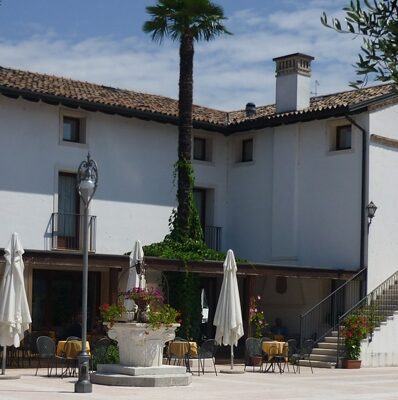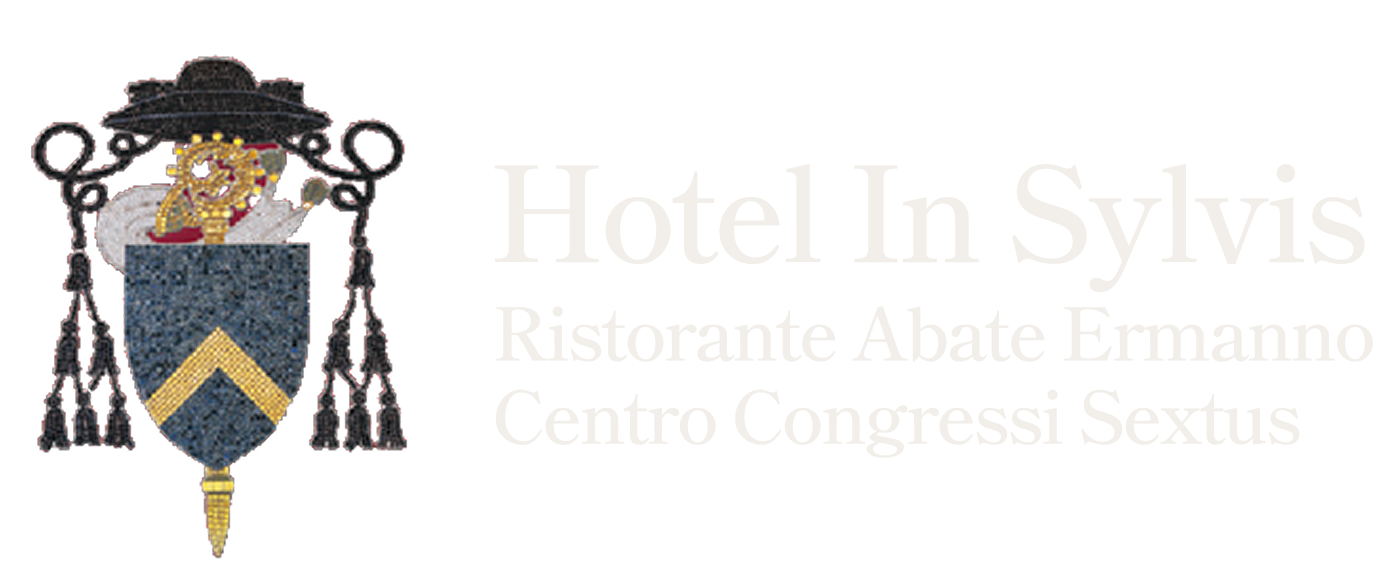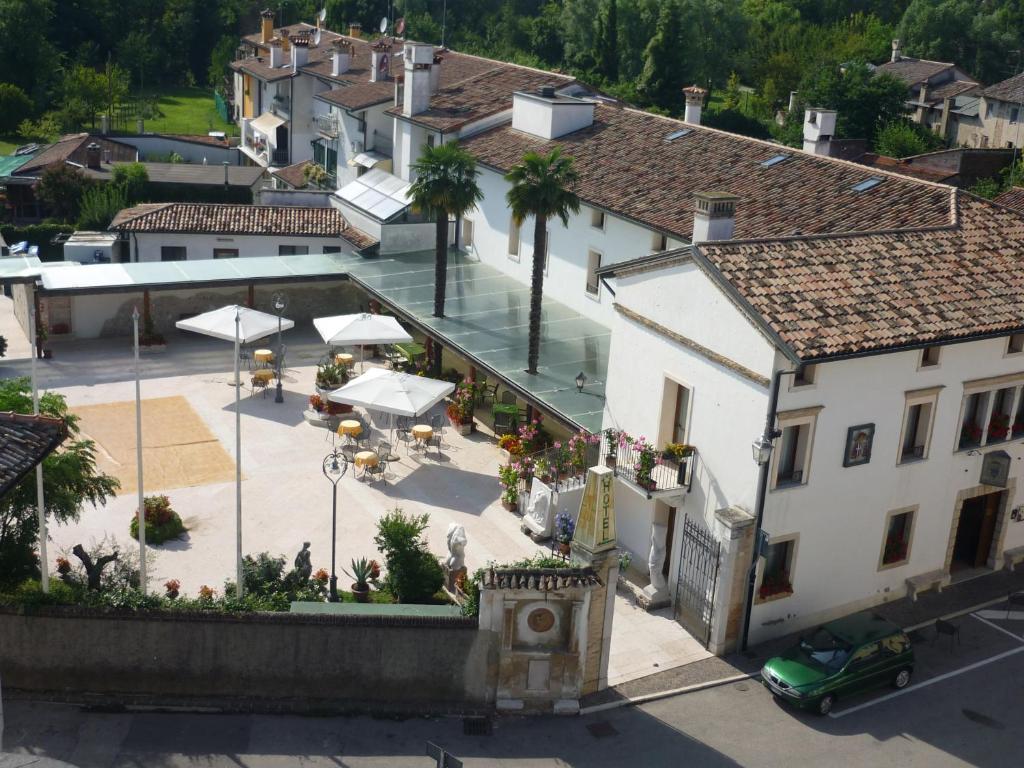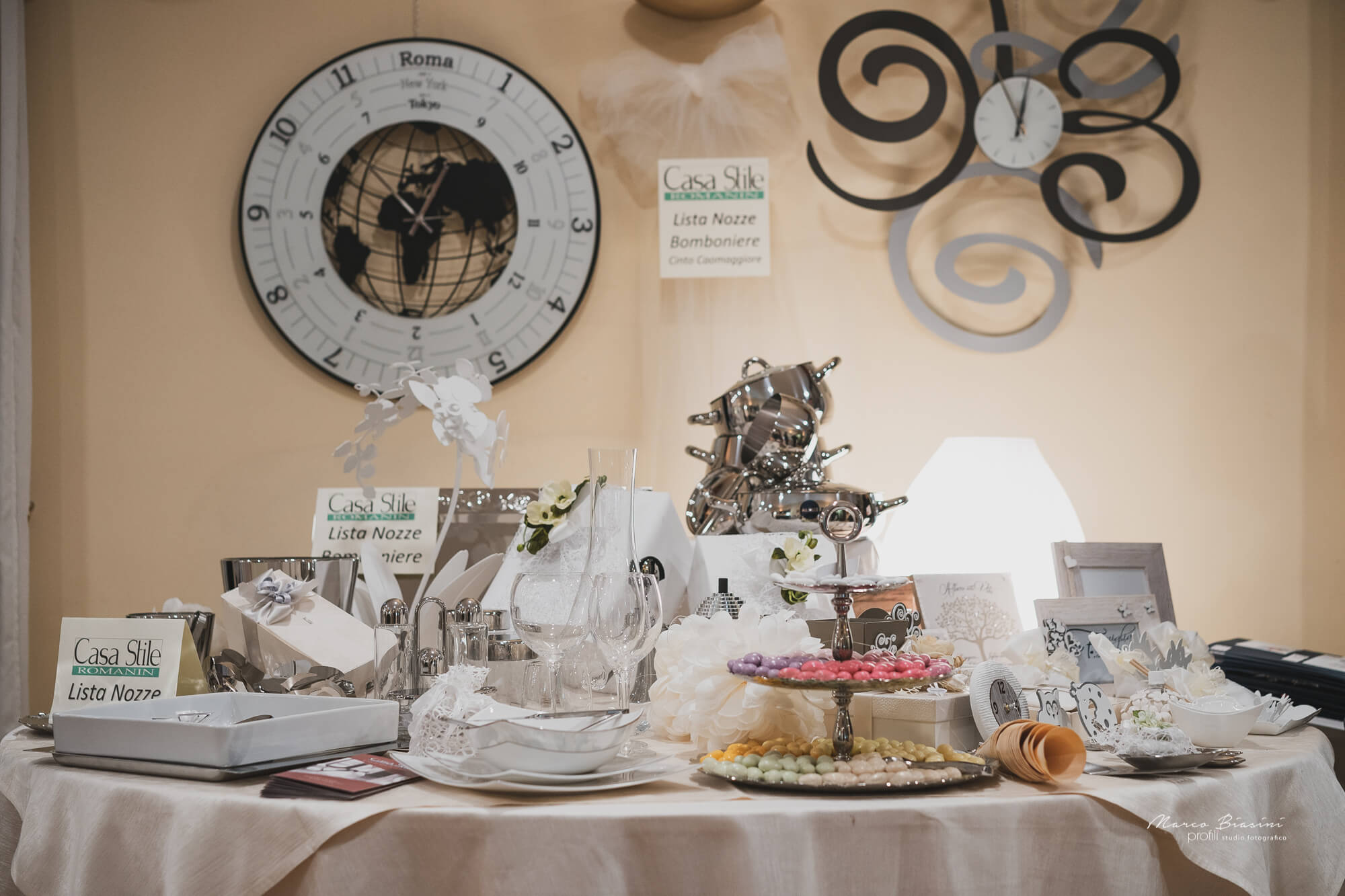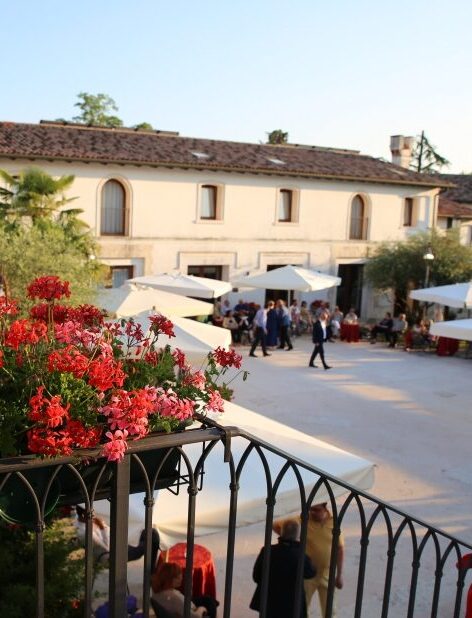since the 2nd century BC
Our story begins in the 2nd century B.C., when the present hotel was an ancient inn and post station, known for serving wine, oil and garum, like the best hotels in the Roman Empire. Such was its fame that the owner, VENETEIA MAXIMA, was granted the honour of a personal tomb, a rare privilege for a woman of the time. Her memorial stone is today kept in the lapidarium of the Abbey of Santa Maria In Sylvis, a few steps away.
The inn was destroyed by the passage of Attila and the Huns, only to be reborn in 1250 as a fortress thanks to ABATE ERMANNO. In 1441, Cardinal PIETRO BARBO (the future Pope PAUL II) ordered its renovation, which was completed by his nephew, Abbot GIOVANNI MICHIEL, a member of the Knights Templar order. During this period, the Abbey and the hotel experienced their greatest splendour, taking the name Hospitale Profano, then Palazzo.
With the end of the Templars, decadence began. In 1790 the Palace passed to the Marquisate of Sesto, then it was transformed into a Napoleonic Post Station by Major GIUSEPPE MARIENI, with horses, carriages, staff and military garrison. At the end of the Republican era, it became a private residence and passed between various families, up to the Vit family, who in 1998 carried out a careful restoration, returning the structure to its original function as a hotel.
Today, artefacts found during the work testify to the long history and the link with the Abbey and the Templars. Each room of the hotel is dedicated to personalities who have marked its past, as a tribute to those who contributed to making it unique. After 2,000 years, the ancient hotel has returned to its splendour: on 19 October 1999, His Excellency Sennen Corrà, the 75th Bishop of the diocese of Concordia-Pordenone, inaugurated the Hotel In Sylvis and the Abate Ermanno Restaurant.
Places of interest + -
The fortified Abbey of "Santa Maria In Sylvis” owes its name to the thick forest in which it was originally settled, and is one of the most important Benedictine centers in Friuli-Venezia Giulia. Built in the 8th century by a noble Lombard family, closely tied to the rulers of Cividale, it was subsequently destroyed by the invading hordes of Attila the Hun, and rebuilt by the end of the 10th century. Archaeological excavations around the Church uncovered an earlier building and some tombs. The newly unearthed building turned out to be an ancient pagan Roman temple. That this place belonged to the Knights Templar, is proven by the little portico on the left side of the entrance hall called “La Loggetta”. In fact, there was a certain friendship and brotherhood between the Benedictines and the Templars. In the little lodge there is a fresco, depicting the protagonists of the “Chanson De Roland”, evidence of the Knights' presence here.
Paradise watching hell + -
The Church, built in the Romanesque style, may be reached at the end of a long atrium framed by two rows of 4 columns. As you enter, you are confronted by two majestic scenarios - Hell on the left and Paradise on the right. The Inferno is depicted vividly and it is impossible for the visitor to remain unmoved upon ‘witnessing’ the torture inflicted on the ‘damned souls’. However, the most powerful image is on the right side, in Paradise, where all the ‘blessed souls’ observe, without emotion, the terrifying scenes in front of them. There is the coronation of Mary in the center, but only a few of them are turned in that direction. The majority of the souls are looking towards us, therefore have the blood curdling scene from Hell in front of them. Another particularity is that while the Paradise fresco is well preserved, the Hell fresco appears damaged in several areas. The reason for this anomaly is the medieval practice of throwing stones against the ‘Demon’, to purify themselves from sin before entering the church.
The gaze between Jesus and a Lady + -
On exhibit inside the building are several frescoes, that were detached from their original walls in the 15th century. They depict various crowned female figures, to whom no particular significance has been attributed. One lady is kneeling, while another has her arms crossed on her chest, contemplating the face of Jesus behind a cloud. This is not just ‘any old fresco’.
It recalls the secrets kept by the Templars, and may refer to the biggest secret of them all. Observing attentively, one can see the profound understanding between Jesus and the Crowned Lady, who is gazing at his face, smiling. At the same time, Jesus does not appear triumphant between the angels in the rays of light – only their knowing looks identify them as custodians of the same secret. If this were the fruit of the symbology employed by the Order of the Knights, then she could be Mary Magdalene.
Saint Anastasia's urn + -
It is located in the centre of the crypt and is among the most precious treasures of Friuli. The material is pure white marble. The urn appears for the first time in 1339 described in a parchment that is still preserved in the Udine library.
Characters + -
The Frattina, Knights and Abbots but also heretics and rebels
For four centuries, the Frattinas were faithful vassals of the Patriarchs, lords of a land in which the Patriarchate of Aquileia would extend, at the time covered by thick forest. Their castle stood on the western edge on the road from Pravisdomini to the Livenza river.
Testimony to the fame and prestige enjoyed by the powerful family was the appointment of Ermanno in 1245 as Benedictine Abbot of the Abbey of Sesto al Reghena. It was he who ordered the reconstruction of today's Hotel In Sylvis as a fortress to protect the Abbey. The then rich and powerful family continued to enjoy important friendships for two centuries, and some of its members distinguished themselves for important military merits that led to the ennoblement of the House by Emperor Charles V, who named Marquardo della Frattina Count Palatine, a title transmissible to male heirs. The decadence began in 1568 when Isabella della Frattina di Portogruaro was condemned for heresy and her husband and son banished forever from the Serenissima for having beaten a Venetian nobleman Public Official in Annone Veneto.
Pietro Barbo, Pope Paul II
He became Pope at the age of 47. He was a noble and gentle mannered Venetian patrician, who was liberal, vane and a lover of excessive luxuries, capable of extravagant gestures of generosity. He owned a private pharmacy, where he dispensed free medicines to the people.
His, was one of the most peaceful Papacies in Rome. He revived the Carnival and Pagan celebrations at his expense. There were great parties held under the Pope’s palace, followed by games and races. It was said at the time, that this was done to distract the people from the idea of liberty, and to maintain his temporary power intact. “ A people who has fun, is not a people that conspire.”, he was reported to have said He also had a habit of throwing gold coins from his balcony in Palace Venezia - today’s San Marco Palace. Under his rich Papacy, several Roman monuments were restored, however a Crusade against the Turks was launched, as well.
At a turning point of this bloody enterprise, he succeeded to form an alliance with the Conqueror of Persia Hassan Beg. Soon after he died suddenly from a heart attack, in his bedroom, at the age of 55. He did not live to see the results of his bloody undertaking or to inaugurate the Jubilee year, designated by him in 1475.
The Templar Giovanni Michiel
The nephew of Pietro Barbo, completed the rebuilding of the Secular Inn(later renamed The Palace) that is today Hotel In Sylvis. At that time, the Inn serviced the Abbey and it’s illustrious guests. Today, under the portal of Santa Maria In Sylvis there is a fresco bearing the family Coat-of-Arms of the Abbott Commendator Giovanni Michiel (1464 – 1503), featuring the Cardinal’s Hat. Giovanni Michiel had Venetian Origins, and was the author of The Rulle, and was affiliated to the Order of the Knights Templars. He also commissioned the fresco of San Benedetto on the Bishop’s Throne.
GIUSEPPE MARIENI He was born in Averara Bologna, on 11 March 1774. His Father died when he was very young, so he was raised and educated by Brother/Fryer Don Carlo Bernardo and his uncle, Don Fancesco Provost of Averara. He was enrolled in the Mariano College of Bergamo and after graduating as an engineer joined the French Military. His meteoric rise saw him in charge of very important and prestigious projects with ample scope to prove his solid preparation and sense of duty. He took part in the Campaign to Russia, and in 1812 was named, Head Genius.
As a Battalion Commander, he had a leading role in building the Bridges of Beresina, which made possible the retreat of Napoleon’s Artillery. He died from typhoid fever, contracted from his friend and brother-in-arms Colonel of the Genius Zanardini, another hero of Beresina. Marieni was only 39 years old.
Giuseppe Marieni
He was born in Averara (BG) on 11 March 1774 and, left fatherless at a very young age, he received his education and schooling from his brother Don Carlo Bernado and his uncle Don Francesco, provost of Averara.
He then enrolled at the Mariano College in Bergamo where, after graduating in engineering, he was attached to the military genius, soon taking on important assignments in which he was able to demonstrate ample preparation and a sense of duty.
He took part in the Russian campaign and in September 1812 was appointed Chief of the Engineer Corps.In command of his battalion, he played a leading role in the construction of the famous bridges of the Beresina that enabled the retreat of Napoleon's army.He died at only 39 years of age from typhus contracted by his friend and comrade-in-arms, Engineer Colonel Zanardini, also a hero of the Beresina.
The kinght's Templars
The poor Fellow Soldiers of Christ from the Temple of Solomon, better known as Knights Templars or simply Templars, was one of the first and better known medieval Christian Knights Religious Orders. The birth of the Order took place in the Holy Land amidst wars between Christian and Islamic forces, that exploded after the first Crusade in 1096. In that time, the roads of the Holy Land were travelled by the pilgrims from Europe, who often were assaulted and robbed. To defend the Holy Places and the pilgrims, various religious orders were formed. Around 1118 – 1119, a group of Knights decided to form the original nucleus of the Templars Order, who undertook the duty to ensure safe passage for the numerous European pilgrims visiting Jerusalem.
The Order was officially recognized in 1129, assuming a monastic code with the support of Bernardo of Chiaravalie. The double role of the monks as soldiers was what distinguished The Templar Order in the years of its maturity. This was a source of bewilderment in Christian circles. Theories, suppositions, fascinating mysteries and legends might never lead to a historically certain answer. However, they do contribute to the great curiosity and interest, in this legendary and chivalrous order. With the passing of time The Templars Order dedicated themselves to agricultural activities, which led to the creation of a highly productive system. They also managed the pilgrims money, and succeeded in creating the most advanced banking network of its time. The Order’s wealth and power grew through the centuries, which provoked the envy of the French King, Philip the Handsome.
A dramatic process began in 1312, that led to the final dissolution of the Order in 1314. The Templars were identifiable by their White, Black or Grey Surcoat. The White one was reserved for the Knights Brothers only, to which later was added a distinct small red cross embroidered on the left side of the garment. This well documented image is engraved in the popular imagination to this day, and is steeped in controversy either for the importance of the order itself, or by modern legends of its presumed persecution ,never proven by historic sources. Some researchers and aficionados of the esoteric and obscure, have symbols of the Order tattooed on their chests or backs, which began from the époque it was created. Those can be seen from various depictions from the 9th century AD as well as in modern cinematography. Amongst the Templars symbols were the ‘beauceant’, their standard, characterized by the aforementioned red cross on a Black and White field, symbolizing the role of the Order as a repository of ‘secret knowledge’.
According to their own legend, the 200 years’ history of the Monk Soldiers reveals an esoteric scientific organization, an occult, a custodian of the knowledge of the obscure. Moreover, the Templars were connected to other legendary and strongly controversial subjects, such as The Red Cross, The Priory of Sion, The Opus Dei-Corpus, The Catars, The Hermits, The Gnosis, the Essenian, and finally to relics of supposed lost teachings of Jesus, The Turin Shroud or ‘Judas testament’. Some speculate, that the Knights Templars were guardians and protectors of the Holy Grail and its true nature: the holder of Jesus’s blood would be the Mother of his progeny Mary Magdalene, wife of Christ. This controversial theory is supported by several symbols, spread in the various Churches with Templar tradition.
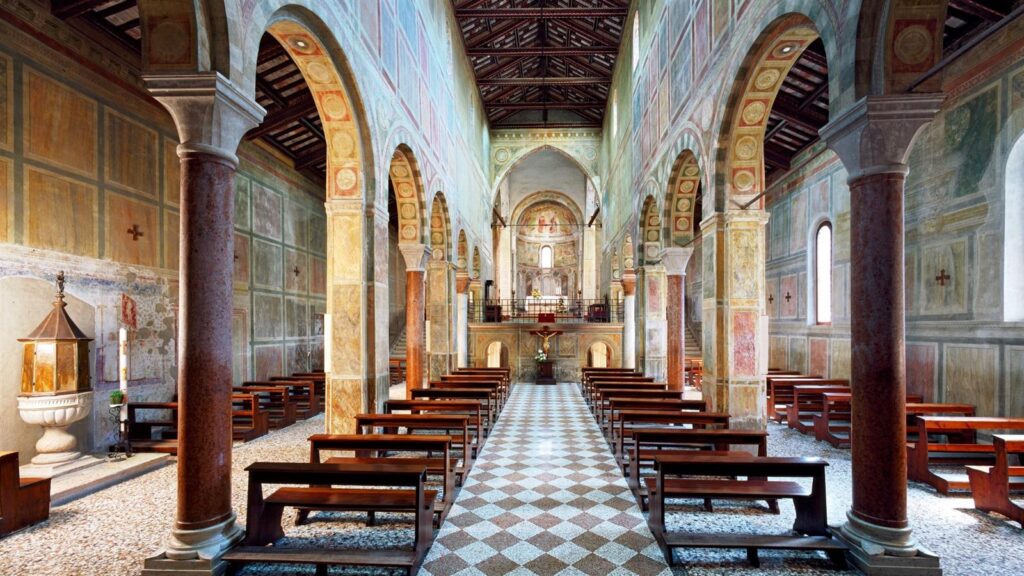
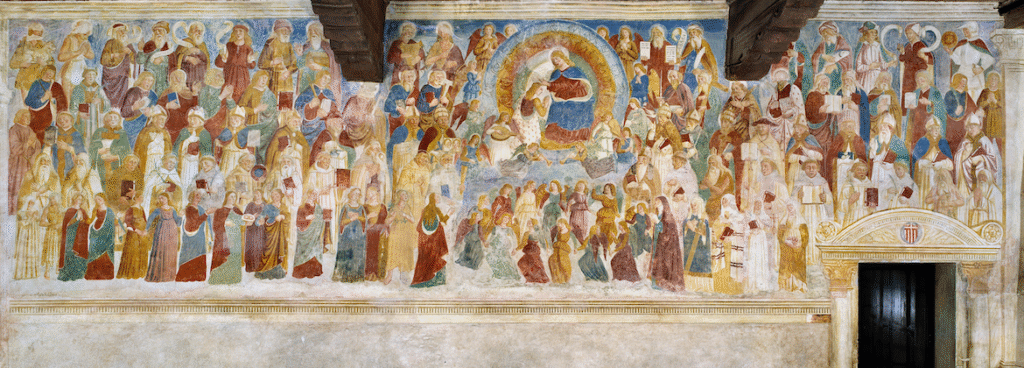
Free On-Site Parking
Sauna and Jacuzzi
Surrounding Green Area
Pet Friendly
Gym
Free Wi Fi
Free On-Site Parking
Sauna and Jacuzzi
Surrounding Green Area
Pet Friendly
Gym
Free Wi-Fi


